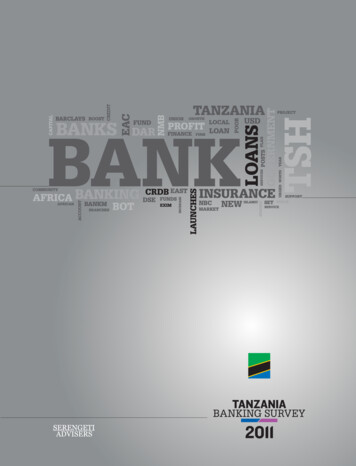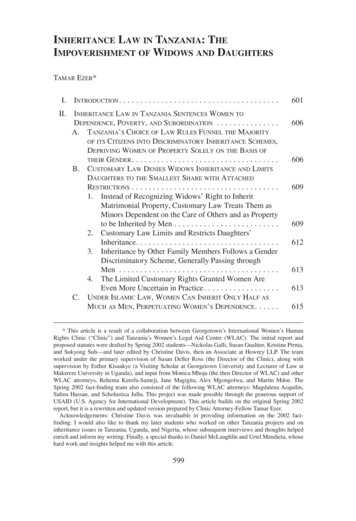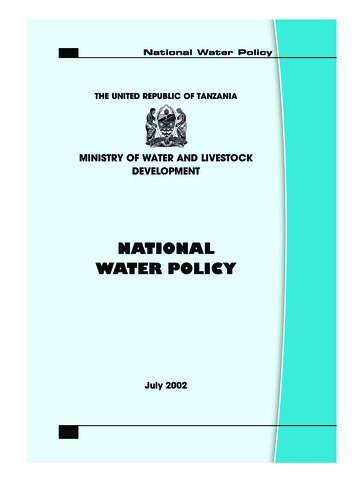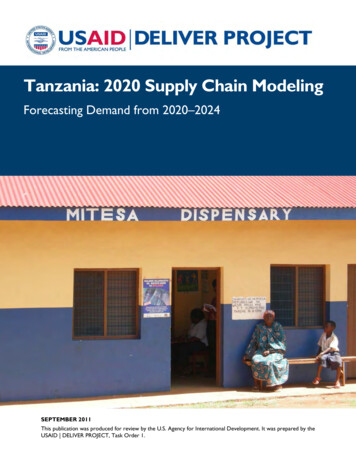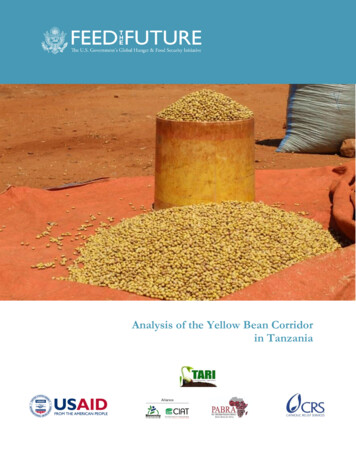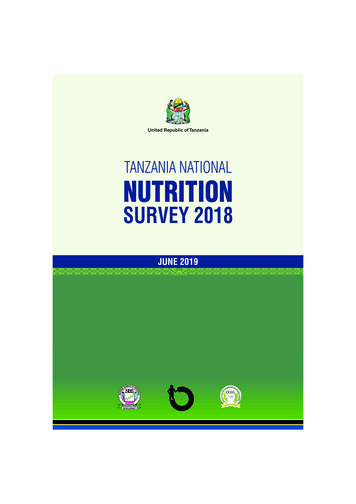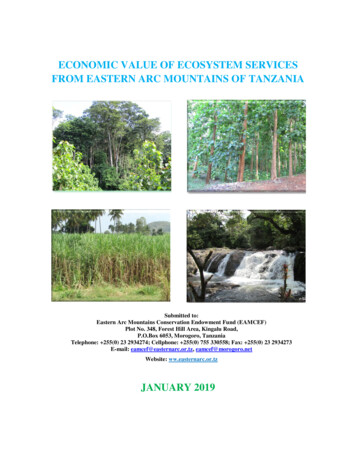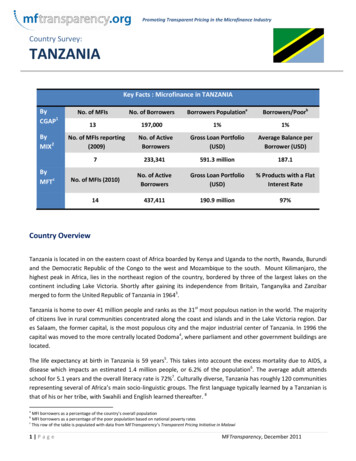
Transcription
Promoting Transparent Pricing in the Microfinance IndustryCountry Survey:TANZANIAKey Facts : Microfinance in TANZANIAByCGAP1ByMIX2ByMFTcNo. of MFIsNo. of BorrowersBorrowers PopulationaBorrowers/Poorb13197,0001%1%No. of MFIs reporting(2009)No. of ActiveBorrowersGross Loan Portfolio(USD)Average Balance perBorrower (USD)7233,341591.3 million187.1No. of MFIs (2010)No. of ActiveBorrowersGross Loan Portfolio(USD)% Products with a FlatInterest Rate14437,411190.9 million97%Country OverviewTanzania is located in on the eastern coast of Africa boarded by Kenya and Uganda to the north, Rwanda, Burundiand the Democratic Republic of the Congo to the west and Mozambique to the south. Mount Kilimanjaro, thehighest peak in Africa, lies in the northeast region of the country, bordered by three of the largest lakes on thecontinent including Lake Victoria. Shortly after gaining its independence from Britain, Tanganyika and Zanzibarmerged to form the United Republic of Tanzania in 19643.Tanzania is home to over 41 million people and ranks as the 31st most populous nation in the world. The majorityof citizens live in rural communities concentrated along the coast and islands and in the Lake Victoria region. Dares Salaam, the former capital, is the most populous city and the major industrial center of Tanzania. In 1996 thecapital was moved to the more centrally located Dodoma4, where parliament and other government buildings arelocated.The life expectancy at birth in Tanzania is 59 years5. This takes into account the excess mortality due to AIDS, adisease which impacts an estimated 1.4 million people, or 6.2% of the population6. The average adult attendsschool for 5.1 years and the overall literacy rate is 72%7. Culturally diverse, Tanzania has roughly 120 communitiesrepresenting several of Africa’s main socio-linguistic groups. The first language typically learned by a Tanzanian isthat of his or her tribe, with Swahili and English learned thereafter. 8aMFI borrowers as a percentage of the country’s overall populationMFI borrowers as a percentage of the poor population based on national poverty ratescThis row of the table is populated with data from MFTransparency’s Transparent Pricing Initiative in Malawib1 P a g eMFTransparency, December 2011
Promoting Transparent Pricing in the Microfinance IndustryPolitical OverviewOn April 26, 1964 the recently independent Tanganyika and Zanzibar signed the Union Agreement to form theUnited Republic of Tanzania. Under the Agreement Zanzibar was given extensive autonomy from mainlandTanzania – it has its own President, legislature and bureaucracy. Although Zanzibar accounts for only 3% of thepopulation, it is guaranteed 15% of seats in the Union Parliament9. All union matters, including foreign affairs,national defense, and police are legislated by the Tanzanian Union and are valid in Zanzibar.The most recent elections in Tanzania were held in October 2010, becoming the fourth multi-party elections sinceindependence. The political party Chama Cha Mapinduzi (CCM) maintained an absolute majority with 80% of theseats in Parliament. Voter turnout was surprisingly low with only 42% of registered voters casting a ballot,compared to a historical 70% rate of voter turnout10. Unlike the peaceful elections in mainland Tanzania, everyelection in Zanzibar has experienced irregularities and occasional violence. This is beginning to change however,and last year the main opposition party, Civic United Front (CUF), and the ruling party were able to reach a powersharing agreement, leading to the first peaceful elections in Zanzibar’s history.Since the 1960’s, Tanzanian leadership has actively supported the efforts of other African nations to gainindependence from colonial powers. The most influential leader in forming Tanzania’s diplomatic policies was itsfirst president, Julius Nyerere. Nyerere championed the Organization of African Unity (OAU) and served aschairman from 1984 to 1985. He also played an active role in anti-apartheid and was one of founding members ofthe Non-Aligned Movement. Tanzania has strong relationships with neighboring nations and has emerged as aleader in solving chronic conflicts, especially in the Great Lakes region. Tanzania has a notable history ofsupporting refugee populations and in 2009 granted citizenship to 169,000 Burundi refugees. From 2005 to 2006,Tanzania was a non-permanent member of the UN Security Council and participated in UN peacekeeping missionsincluding operations in Lebanon and Sudan11.Macroeconomic OverviewTanzania is one of the poorest countries in terms of per capita income, ranking 202nd in the world for purchasingpower parity12. After achieving independence in 1961, the newly formed Tanzanian government implemented asocialist economic system. The following two decades saw severe economic decline. Exchange rates and pricingpolicies were artificially controlled using non-market mechanisms, causing low exports and high inflation. Thesepolicies also crippled agricultural production, the mainstay of Tanzania’s economy, creating widespread shortages.In 1986, the country began taking steps to liberalize the economy, most notably in the agricultural marketingsystem and in domestic prices. Financial reforms were initiated. Nonetheless, economic growth remained sluggishuntil much more aggressive steps were taken in 199613. With the support of the IMF, Tanzania formed a strongMinistry of Finance in 1996, which was pivotal in accelerating fiscal reforms14. In the late 1990’s, real GrossDomestic Product (GDP) growth was less than 5% but in the last seven years it has averaged above 6% annually.This growth also translated to a 40% increase in GDP per capita between 1998 and 200715.2 P a g eMFTransparency, December 2011
Promoting Transparent Pricing in the Microfinance IndustryTanzania is considered to have achieved areasonable growth performance, havingrelatively low underlying inflation, an adequatelevel of monetary reserves and plans to tackleexternal and domestic debt sustainability.However, Tanzania’s economy is still heavilydependent on donor assistance – nearly 30% ofthe budget is provided by outside donors17.GDP and InflationYearGDP(PPP)*GDPGrowthInflationGNI PerCapita on USD, 2010 figures, Source: World Bank16Tanzania enjoyed moderate inflation over the last decade, but it is now struggling to combat the current inflationrate. Tanzania has an external debt of 7.9 billion and the servicing of this debt absorbs about 40% of totalgovernment expenditures18. In an effort to restructure many of its state-owned enterprises, the governmentseparated from them. By 2006 it had divested from 335 out of approximately 425 entities19. Tanzania has alsoqualified for debt relief under the Heavily Indebted Poor Countries (HIPC) Initiative. The IMF’s most recent DebtSustainability Analysis of Tanzania indicates that debt relief under the HIPC combined with sound macroeconomicpolicies place it at low risk of debt distress. Public external debt service was approximately 1% of GDP in 2009 andis expected to remain so for 2010 and 2011.Agriculture is the backbone of Tanzania’s economy, accounts for approximately 29% of GDP and 80% ofemployees. The vast majority of export earnings are dependent onGDP – composition by sector:Agriculture28.8% cash crops21including coffee, tea, cotton, cashews, sisal, cloves andpyrethrum . Although the volume of cash crops has increased inIndustry24.3%recent years, large amounts of produce fail to reach the market. HighServices46.9%food prices have persisted since the price spike in 2008, beingAnnual Trade:contributed to a rise in inflation. Price fluctuations and unreliableImports7,081 cash flow continue to frustrate the region’s already strugglingExports2,664 farmers. Tanzania’s industrial sector is one of the smallest in Africa20Source: 2009 figures World Bank(24.3% of GDP) and is mostly concentrated in Dar es Salaam22.Manufacturing is hindered by a number of factors including the poorly maintained electricity infrastructure andforeign exchange shortages.Zanzibar’s economy is dominated by the production of cloves, although it has taken steps to promote its growingtourism industry. The island's manufacturing sector is limited mainly to import substitution industries, such ascigarettes, shoes, and processed agricultural products. Many new resorts and hotels are sprouting up on popularislands, signaling the promising growth of the tourism sector. However, a prolonged electricity shortage fromDecember 2009 to March 2010 had a severely negative impact on tourism as well as commodity prices, furtherdamaging Zanzibar’s already fragile economy23.Tanzania’s record of political instability and socialist economic policies has discouraged substantial foreigninvestment. The most common complaint of investors, foreign and domestic, is the hostile bureaucracy and theweak judiciary system. Tanzania’s current government has a favorable attitude towards foreign direct investmentand has begun taking steps to improve the business climate. These include redrawing tax codes, floating theexchange rate, licensing foreign banks and creating an investment promotion center. The greatest potential forforeign direct investment is in Tanzania’s mineral resources as well as its largely untapped tourism sector.3 P a g eMFTransparency, December 2011
Promoting Transparent Pricing in the Microfinance IndustryPoverty in TanzaniaAfter four decades of independence Tanzania remains one of the poorest countries in the world. Its GDP is lessthan the averages for Sub-Saharan Africa and East Asia. Although Tanzania’s economy has grown dramatically by5% to 7% annually in the past decade, this has not translated into significant quality of life improvements for themajority of citizens. According to the 2007 Household Budget Survey (HBS), the absolute number of poor hadincreased by 1.3 million since 2000. The National Bureau of Statistics confirms that the number of Tanzanianssurviving on 1.10 a day or less has risen by one million to 12.7 million in the last six years. Researchers havelargely attributed this to an annual population growth of 2.6 percent. The United Nations Human DevelopmentIndex, which measures a range of social and economic indicators, ranks Tanzania the 152th poorest nation out of197. For comparison, Kenya and Uganda, Tanzania’simmediate neighbors, ranked 143th and 161th respectively26.Key Poverty FiguresThe Millennium Development Goal (MDG) set by the UnitedNations aims to reduce the incidence of poverty by 50%GINI37.6between 1990 and 2015. In 1991, 39% of TanzanianGNI per capita (PPP )1,328households were living below the basic needs poverty line.Pop. below 1 a day58% In order to meet the MDG target, this proportion needs toPop. below 2 a day90% be reduced to 19.5% by 2015. Data from the HBS 2000 and2425Sources: Human Development Report 2011 and Earth Trends2007 show a limited decline in income poverty levels over27the period in all areas . Poverty indicators also show a growing disparity in poverty between urban and ruralareas. Approximately 38% of rural households are considered to live below basic needs, compared with 24% ofurban households and 16% in Dar es Salaam. With such low reductions in poverty, Tanzania is unlikely to achieveMDG poverty reduction targets28.HDI0.466Microfinance Industry of TanzaniaIntroductionThe microfinance industry in Tanzania is relatively young and limited in scale. The World Bank estimates that lessthan 20% of Tanzania’s working population – approximately 13 million people – has access to mainstream bankingservices29. In an attempt to address this, many banks have recently begun targeting the poor by extendingcollateral-free and low interest microcredit and loans. Due to lack of skills and experience within the market theseefforts are not widespread and mostly favor borrowers in urban areas, leaving the rural areas largely underserved.Of the estimated 800 institutions providing financial services to low-income borrowers in Tanzania, most arereluctant to move into rural areas due to the poor national infrastructure, perceptions of high risk and due to thehigher expense of operating costs.Since 2003, there have been positive developments in Tanzania’s microfinance industry as numerous banks andfinancial institutions have provided increased funding either directly to beneficiaries or through intermediaryinstitutions. Despite this progress, it is estimated that microfinance service providers have a combined outreachof approximately 500,000 clients, which is only about 5% of the estimated total demand.4 P a g eMFTransparency, December 2011
Promoting Transparent Pricing in the Microfinance IndustryMicrofinance InstitutionsThere are three main categories of microfinance institution (MFI) in Tanzania, the first being non-governmentalorganizations (NGOs). The most prominent NGOs include PRIDE TZ, FINCA, SEDA and PTF. Banking institutions alsooffer a range of microcredit products. The largest banks are the National Microfinance Bank (NMB), CRDB bankand Akiba Commercial Bank (ACB). There are a few regional and community banks, namely Dar es SalaamCommunity Bank, Mwanga Community Bank, Mufindi Community bank, Kilimanjaro Cooperative Bank, MbingaCommunity Bank and Kagera Cooperative Bank. Lastly, cooperative based institutions (SACCOS and SACCAS),which are not regulated by the Bank of Tanzania, provide financial services that are predominately savings based.Examples include Small Industries Development Organization (SIDO), YOSEFO, SELFINA, Tanzania Gatsby Trust,Poverty Africa and the Zanzibar based Women Development Trust Fund.The market share in terms of both loan portfolio and numbers of active borrowers of the largest ten MFIs inTanzania are displayed in the diagrams below.Participated inMFTransparencyPricing Initiative(2011)Microfinance InstitutionNumber ofActiveBorrowersGross Loan portfolio(national currency)Reports toMIX (2009)Akiba Commercial Bank15,63848,100,616,000YBRAC - TZA117,26131,677,570,729YYFINCA - nga Community Bank( Mbinga CB)12,9634,600,000,000YYNational Microfinance Bank (NMB)46,000104,000,000,000YYPresidential Trust Fund (PTF)7,9831,934,424,523PRIDE - TZA72,97743,066,352,000Sero Lease and Finance Limited (SELFINA)8,2435,000,000,000Small Enterprise Development Agency (SEDA)21,3475,900,000,000Tujijenge Tanzania LTD17,8274,529,260,138Y17,1353,516,132,881YYouth Self Employment Foundation (YOSEFO)YYYSource: MFIs according to MFTransparency data 2011 & MIX data 20105 P a g eMFTransparency, December 2011
Promoting Transparent Pricing in the Microfinance IndustrySource: MFIs according to MFTransparency data 2011 & MIX data 2010Another noteworthy group of Tanzanian microfinance service providers consists of non-institutional actors whogenerally operate in the informal sector. These include rotating savings and credit groups, rural savings and creditschemes, and moneylenders. Although there are numerous providers in this field, there are no reliable statisticson their lending patterns. These providers operate informally and offer valuable, but limited and often expensivemicrofinance services.National Microfinance NetworksTanzanian Association of Microfinance Institutions (TAMFI)Comprised of 41 member groups including 2 commercial banks, 3 community banks and 36 NGOs, TAMFI is theumbrella organization for microfinance institutions operating in Tanzania.30 TAMFI is an open forum devoted to6 P a g eMFTransparency, December 2011
Promoting Transparent Pricing in the Microfinance Industrystrengthening the microfinance sector by promoting cooperation and collaboration among its members. Throughlobbying and advocacy, TAMFI aims to create and maintain a strong regulatory framework for Tanzania’smicrofinance industry31. TAMFI also carries out research relevant for MFI development in Tanzania and providesviable suggestions to member organizations. Membership is voluntary and open to all institutions involved inmicrofinance activities, including commercial banks and financial institutions, community banks, NGOs andSACCOs.32Tanzania Federation of Cooperatives (TFC)Tanzania Federation of Cooperatives is the national umbrella organization for cooperative-based institutions. Itpromotes and coordinates the development of all cooperative-based institutions33. Founded in 1994, TFC is anautonomous, non-governmental and non-partisan body that is member owned and managed. The foundingmembers consist of five National Cooperative apexes from tobacco, cotton, coffee, cashew and cereal and otherproduce industries; two specialized Unions (Savings and Credit Cooperative Union of Tanzania – SCCULT, andTanzania Industrial Co-operative Union) and six Cooperative Unions.34 TFC replaced the then Cooperative union ofTanzania (CUT) following the enactment of the new Cooperative Act in 1991, which rescinded the politicalassociation of the current ruling party. The Cooperative Act of 1991 stressed the importance of an autonomouscooperative body with member empowerment, resulting in the formation of the TFC. Currently, the cooperativemovement comprises of about 6,000 Cooperative Societies having about 700,000 members. 35Savings and Credit Cooperatives Union League of Tanzania (SCCULT)SCCULT is National Association of SACCOS in mainland Tanzania and was formed in 1992. It was registered on 19thOctober 1992. SCCULT is governed by an elected nine member Management Board. Currently SCCULT has 671members SACCO affiliates. The role of SCCULT is to promote, develop and strengthen SACCOS in Tanzania byproviding diverse financial services in a competitive environment. The goal of these efforts is to assist individualsin alleviating poverty, commanding respect and dignity, and promoting equity and justice. 36The Community Banks Association (CBA)The Community Banks Association was founded by Tanzania Gatsby Trust (TGT) in liaison with all communitybanks in Tanzania in the year 2005. The Association was registered under the Societies Ordinance of 1954 (rule 5)with Registration issued on 1st day of February 2006. The association is an instrument for Delivering Financial andNon-Financial Services to Community Banks which serves the micro, small and medium sized enterprises,considered to be the true engines of economic growth. The CBA’s Mission is ‘‘to mobilize resources so as tomaximize value and economically empower community banks in Tanzania by offering financial and non-financialresources efficiently and effectively for mutual benefit of all parties’’ 37Savings and Credit Cooperatives (SACCOs)Savings and Credit Cooperatives were first established in Tanzania in the 1920s and have since played a vital rolein the country’s economic and social development. The principle behind cooperatives is that they are owned and7 P a g eMFTransparency, December 2011
Promoting Transparent Pricing in the Microfinance Industrycontrolled by their own members in the community. Figures from 2006 showed that there were 1,507 registeredSACCOS with 217,418 individual members in Tanzania, although only 761 were listed as active SACCOs. Thecooperatives serve an estimated 130,000 clients, most of whom are savers. There are nearly twice as manySACCOS based in urban areas than rural – 415 versus 242 cooperatives respectively. 38Tanzanian cooperatives provide a valuable service to low-income borrowers, offering a safe place to make savingsand access loans. In 2006, almost 700 SACCOs were affiliated with SCCULT, accounting for 92,687 individualmembers. However, the SACCOS in Tanzania have been accused of being “unable to cope with modern realities”,their image having been tarnished by poor administration, poor leadership, unreliable business practices, andcorruption39.Tanzanian cooperatives need to undergo a comprehensive transformation and refocus attention on their foundingprinciples in order to survive. To be successful, cooperatives must be sustainable, viable business enterprises thatmaintain the trust of their communities. A number of significant steps have been taken in the last ten years tohelp revive this sector, including the 2000 Special Presidential Committee on reviving cooperatives and the newcooperative legislation of 2004. These efforts culminated in the writing of a key strategic document, TheCooperative Reform and Modernization Program 2005-2015. This is a home grown initiative and was producedwith the direct involvement of Tanzanian cooperatives, rather than by external consultants. A number ofimportant issues were identified. These included concerns about poor management, inappropriate cooperativestructures, a lack of working capital, a lack of cooperative democracy and education, weak supporting institutions,and some instances of corruption and embezzlement. The Program is now working towards establishingeconomically strong cooperative societies that are capable of facing competitive challenges, and an empoweredmembership with good governance and accountability. The aim is to develop a network of cooperatives that hasan efficient and cost effective structure, and is able to respond easily to the needs of its members.The program is a part of a larger effort on behalf of the Tanzanian government to promote economicdevelopment, including MKUKUTA – the National Strategy for Growth and Reduction of Poverty adopted in June200540. In October 2010, Tanzania also invited the World Council of Credit Unions (WOCCU) to develop a strongerregulatory framework for the credit union sector. Additionally, WOCCU hopes to address the scarce liquidity andlong waiting periods to obtain a loan with SACCOS. Many of these organizations are volunteer-run and despiteefforts taken by the Bank of Tanzania, regulation and supervision have been virtually non-existent in rural areas ofthe country. This is particularly important as the number of financial cooperatives in Tanzania has exploded inrecent years, increasing over 50% in only three years. Despite the proliferation of SACCOS, no single entityprovides centralized financial or statistical information on the institutions. As the SACCOS sector continues togrow, it faces an increasing need for central oversight to ensure appropriate the financial discipline needed toprotect member savings. 41Funders and DonorsThe international donor agencies provide not only substantial financial resources to serve as loan and investmentcapital for microfinance NGOs but they also technical assistance for staff capacity building and technology transferof best practice in microfinance42. In this context they comprise a significant and influential stakeholder group inTanzanian microfinance. The list of recipients include Bank of Tanzania, the High Court and Commercial Court, TheMinistry of Cooperatives and Marketing, the second tier and third tier organizations for cooperative societies as8 P a g eMFTransparency, December 2011
Promoting Transparent Pricing in the Microfinance Industrywell as the primary SACCOs, the commercial banks, the regional and rural unit banks providing microfinanceservices such as Kilimanjaro Cooperative Bank, Mufindi Community Bank and Mwanza Rural Community Bank, aswell as the numerous microfinance NGOs including the newly established NGO network organization – TanzaniaAssociation of Microfinance Institutions43.An important item that needs to be properly recognized by the Tanzanian microfinance industry is that continuedreliance and dependence on donor funds and assistance is not viable, and that this particular resource will atsome point be exhausted. Microfinance under private initiative is a relatively new development in Tanzania whencompared to other countries, and the industries stakeholders have been encouraged towards placingmicrofinance development on a sustainable path. External advisers and consultants can assist in the constructionand crafting of a legal and regulatory framework for the sector but the primary responsibility for incorporatingthese into the design of the framework must belong to local stakeholders. Establishing effective coordination willbe beneficial, not only for the international donors but for the microfinance institutions themselves44. Withoutcoordinated efforts, there will continue to be instances of NGOs changing and shifting their focus so as to fitdonors’ goals, and of the scarce resources becoming less productive.Microfinance RegulationCentral BankIn 1995 the Bank of Tanzania (BoT) moved away from its former multiple-policy objectives to focus on a singlepolicy objective – establish monetary conditions conducive to price stability. The BoT Act of 1995 states, 45“The primary objective of the Bank shall be to formulate and implement monetary policy, directed tothe economic objective of maintaining price stability, conducive to a balanced and sustainable growthof the national economy of Tanzania”By increasing uncertainty in future prices, inflation adversely affects decisions related to consumption, saving,borrowing, and capital investments. Excessive inflation can also drastically impede economic development, as itadversely affects interest and exchange rate stability – two pivotal aspects of Tanzania’s Financial and EconomicRestructuring Program. The Bank of Tanzania is committed to combating the critical inflationary situation in thecountry and has declared inflation to be the nation’s “economic enemy number one”. To achieve this objective,the BoT plans to implement initiatives around a refinancing policy, minimum reserve policy, open market policy,foreign exchange interventions and other instruments.National Microfinance PolicyThe Tanzanian government has voiced concern over the alarming state of poverty and is actively involved inprograms focused on stimulating poverty alleviation. The government views microfinance institutions as apowerful weapon in combating poverty and to this end has been keen to improve and develop the microfinanceindustry. It has established a fully-fledged Directorate of Microfinance within the Bank of Tanzania, which hasspearheaded several influential programs, including the formation of the National Microfinance Policy.46Established in 2002, the National Microfinance Policy provides the legal, regulatory and supervisory framework for9 P a g eMFTransparency, December 2011
Promoting Transparent Pricing in the Microfinance Industrymicrofinance activities. The entire process to write the comprehensive legislation, from policy formulation to thedevelopment of legal, regulatory and supervisory framework, was highly participatory involving all thestakeholders in the industry including MFIs. It aims to serve the low-income segment of society by building anefficient micro financial system, thereby making banks more effective in poverty reduction. This policy focuses onserving households, small holder farmers and small micro-enterprises in rural as well as urban areas47.The legislation was concluded in 2003 by an amendment of the Banking and financial Institutions Act 1991, Bankof Tanzania Act 1995 Cooperative Societies Act 1991, and other related statutes. This gave the BoT the mandateto license, regulate and supervise deposit taking equity-based microfinance companies48. The legislation alsoempowers the BoT to regulate and supervise cooperative based institutions whose sizes are above a certainthreshold. Under the framework, MFIs could now be licensed to take public deposits and hence carry out financialintermediation just like banks. Under the legal framework, the credit only NGOs are not subjected to prudentialnorms but are required to abide by non-prudential guidelines and supervision under the Ministry of Finance.Supervisory FrameworkThe National Microfinance Policy has been amended over time to give the BoT the mandate to license, regulateand supervise deposit equity-based microfinance institutions49. Furthermore, the policy gives the BoT regulatoryoversight over cooperative based institutions that are above a certain size. The law has established a tieredsystem of regulation to supervise microfinance institutions, as outlined below:Supervisory AuthorityInstitutions to besupervisedResponsibilitiesBank of Tanzania Commercial BanksFinancial Institutions(including MFCs)FICOS License MFCsLicense FICOSReview microfinance operations of commercial banksand other financial institutions (whose core business isnot microfinance) through segmented financial reportingConduct on-site and off-site examinationsReview external audit reports and conduct randomexaminations of audit firmsRegistrar of CooperativesSACCOS Register SACCOSConduct on-site and off-site examinations of SACCPSReview external audit reports and conduct randomexaminations of audit firmsMinistry of FinanceNGOs Review external audits prior to authorizing disbursementof funds provided by Government or donorsGrant accreditation to NGOs as “Micro-creditInstitutions-MCIs”In coordination with NBAA review external audit reportand conduct random examinations of audit firmsmonitoring the respective NGOs 10 P a g eMFTransparency, December 2011
Promoting Transparent Pricing in the Microfinance IndustryThe Rural Finance Services Strategy (RFSS)Rural Tanzanians have little access to financial services. Nearly one third have no access at all; 29% use nonmonetary means to transact and 28% use informal financial service providers. Only 4% use semiformal providers,while just 8% have access to a bank account or insurance policy50. The Rural Financial Services Strategy (RFSS) isan action plan to enhance the provision of financial services to Tanzania’s rural areas. It was developed to try andresolve some of the complexity caused by the existing rural finance policy framework, stemming from themultiple policy efforts intended to streamline microfinance and rural finance. The RFSS was
qualified for debt relief under the Heavily Indebted Poor ountries (HIP) Initiative. The IMF's most recent Debt Sustainability Analysis of Tanzania indicates that debt relief under the HIPC combined with sound macroeconomic policies place it at low risk of debt distress. Public external debt service was approximately 1% of GDP in 2009 and
